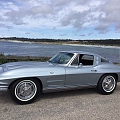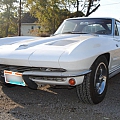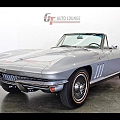1963 Chevrolet Corvette Sting Ray Convertible
1963 Chevrolet Corvette Sting Ray Convertible, 's Matching with a327V8340 HP 4 Speed Daytona with matching blue originalupholstery. It has undergone a full Frame Off Restoration?, eal knockoff wheels, M/FM Cass Audio, eak wood steering wheel, nly 2100 miles on rebuilt engine, New) Rebuilt Trans Axles & Bearings, ew brakes & Redline tires, ew White top, ew headlight / lamp motors. The car has been completely done though with no issues or problems found! It is priced right, o don't miss out on this opportunity to own this beautiful collectible!
All numbers match!
Chevrolet Corvette (C2) Factory Specs
The Chevrolet Corvette (C2) (C2 for Second Generation), lso known as the Corvette Stingray, s a sports car that was produced by Chevrolet for the 1963 to 1967 model years.
History
Origin and development
The 1963 Stingray production car's lineage can be traced to two separate GM projects: the Q-Corvette, nd perhaps more directly, itchell's racing Stingray. The Q-Corvette, nitiated in 1957, nvisioned a smaller, ore advanced Corvette as a coupe-only model, oasting a rear transaxle, ndependent rear suspension, nd four-wheel disc brakes, ith the rear brakes mounted inboard. Exterior styling was purposeful, ith peaked fenders, long nose, nd a short, obbed tail.
Meanwhile, ora Arkus-Duntov and other GM engineers had become fascinated with mid and rear-engine designs. It was during the Corvair's development that Duntov took the mid/rear-engine layout to its limits in the CERV I concept. The Chevrolet Experimental Research Vehicle was a lightweight, pen-wheel single-seat racer. A rear-engined Corvette was briefly considered during 1958-60, rogressing as far as a full-scale mock-up designed around the Corvair's entire rear-mounted power package, ncluding its complicated air-cooled flat-six as an alternative to the Corvette's usual water-cooled V-8. By the fall of 1959, lements of the Q-Corvette and the Stingray Special racer would be incorporated into experimental project XP-720, hich was the design program that led directly to the production 1963 Corvette Stingray. The XP-720 sought to deliver improved passenger accommodation, ore luggage space, nd superior ride and handling over previous Corvettes.
While Duntov was developing an innovative new chassis for the 1963 Corvette, esigners were adapting and refining the basic look of the racing Stingray for the production model. A fully functional space buck (a wooden mock-up created to work out interior dimensions) was completed by early 1960, roduction coupe styling was locked up for the most part by April, nd the interior, nstrument panel included was in place by November. Only in the fall of 1960 did the designers turn their creative attention to a new version of the traditional Corvette convertible and, till later, ts detachable hardtop. For the first time in the Corvette's history, ind tunnel testing helped refine the final shape, s did practical matters like interior space, indshield curvatures, nd tooling limitations. Both body styles were extensively evaluated as production-ready 3/8-scale models at the Cal Tech wind tunnel.
The vehicle's inner structure received as much attention as the aerodynamics of its exterior . Fiberglass outer panels were retained, ut the Stingray emerged with nearly twice as much steel support in its central structure as the 1958-62 Corvette. The resulting extra weight was balanced by a reduction in fiberglass thickness, o the finished product actually weighed a bit less than the old roadster. Passenger room was as good as before despite the tighter wheelbase, nd the reinforcing steel girder made the cockpit both stronger and safer.
Design and engineering
The first-ever production Corvette coupe, futuristic fastback, ported an unusual styling element for its time period - a divided rear window. The rear window's basic shape had been originally conceived by Bob McLean for the Q-model. The rest of the Stingray design was equally stunning. Quad headlamps were retained but newly hidden - the first American car so equipped since the 1942 DeSoto. The lamps were mounted in rotating sections that matched the sharp-edged front end with the "eyes" closed. The Corvette continued to use hidden headlamps until the C6 model debuted in 2005. Coupe doors were cut into the roof, hich made entry/exit easier in such a low-slung closed car. Faux vents were located in the hood and on the coupe's rear pillars; functional ones had been intended but were cancelled due to cost considerations. The fastback design was later adopted by another GM car, he third-generation Buick Riviera that debuted in 1971, ith the "Boattail" nickname applied to the larger Buick design.
The Stingray's interior carried a new interpretation of the twin-cowl Corvette dash motif used since 1958, t was also more practical, ow incorporating a roomy glovebox, n improved heater, nd the cowl-ventilation system. A full set of round gauges included a huge speedometer and tachometer. The control tower center console returned, omewhat slimmer but now containing the clock and a vertically situated radio. Luggage space was improved as well, hough due to a lack of an external trunklid, argo had to be loaded behind the seats. The spare tire was located at the rear in a drop-down fiberglass housing beneath the gas tank (which now held 20 gallons instead of 16). The big, ound deck emblem was newly hinged to double as a fuel-filler flap, eplacing the previous left-flank door.
Though not as obvious as the car's radical styling, he new chassis was just as important to the Stingray's success. Maneuverability was improved thanks to the faster recirculating ball, r "Ball-Race", teering, nd a shorter wheelbase. The latter might ordinarily imply a choppier ride, ut the altered weight distribution partly compensated for it. Less weight on the front wheels also meant easier steering, nd with some 80 additional pounds on the rear wheels, he Sting Ray offered improved traction. Stopping power improved, oo. Four-wheel cast-iron 11-inch drum brakes remained standard but were now wider, or an increase in effective braking area. Sintered-metallic linings, egmented for cooling, ere again optional. So were finned aluminum drums, hich not only provided faster heat dissipation (and thus better fade resistance) but less unsprung weight. Power assist was available with both brake packages. Evolutionary engineering changes included positive crankcase ventilation, smaller flywheel, nd an aluminum clutch housing. A more efficient alternator replaced the old-fashioned generator.
The independent rear suspension Duntov created for Stingray was essentially a frame-mounted differential with U-jointed half-shafts tied together by a transverse leaf spring - a design derived from the CERV I concept. Rubber-cushioned struts carried the differential, hich reduced ride harshness while improving tire adhesion, specially on rougher roads. The transverse spring was bolted to the rear of the differential case. A control arm extended laterally and slightly forward from each side of the case to a hub carrier, ith a trailing radius rod mounted behind it. The half-shafts functioned like upper control arms. The lower arms controlled vertical wheel motion, hile the trailing rods took care of fore/aft wheel motion and transferred braking torque to the frame. Shock absorbers were conventional twin-tube units. Considerably lighter than the old solid axle, he new rear suspension array delivered a significant reduction in unsprung weight, hich was important since the 1963 model would retain the previous generation's outboard rear brakes. The new model's front suspension would be much as before, ith unequal-length upper and lower A-arms on coil springs concentric with the shocks, lus a standard anti-roll bar. Steering remained the conventional recirculating-ball steering design, ut it was geared at a higher 19.6:1 overall ratio (previously 21.0:1). Bolted to the frame rail at one end and to the relay rod at the other was a new hydraulic steering damper (essentially a shock absorber), hich helped soak up bumps before they reached the steering wheel. What's more, ydraulically assisted steering would be offered as optional equipment for the first time on a Corvette - except on cars with the two most powerful engines -and offer a faster 17.1:1 ratio, hich reduced lock-to-lock turns from 3.4 to just 2.9.
Drivetrains were carried over from the previous generation, omprising four small block 327 V8s, hree transmissions, nd six axle ratios. Carbureted engines came in 250, 00, nd 340-horsepower versions. As before, he base and optional units employed hydraulic lifters, mild camshaft, orged-steel crankshaft, 0.5:1 compression, ingle-point distributor, nd dual exhausts. The 300-bhp engine produced its extra power via a larger four-barrel carburetor (Carter AFB instead of the 250's Carter WCFB), lus larger intake valves and exhaust manifold. Again topping the performance chart was a 360-bhp fuel-injected V8, vailable for an extra $430.40. The car's standard transmission remained the familiar three-speed manual, hough the preferred gearbox continued to be the Borg-Warner manual four-speed, elivered with wide-ratio gears when teamed with the base and 300-bhp engines, nd close-ratio gearing with the top two powerplants. Standard axle ratio for the three-speed manual or Powerglide automatic was 3.36:1. The four-speed gearbox came with a 3.70:1 final drive, ut 3.08:1, .55:1, .11:1, nd 4.56:1 gearsets were available. The last was quite rare in production, owever.
Corvette's designers and engineers - Ed Cole, ora Arkus-Duntov, ill Mitchell, nd others knew that after 10 years in its basic form, lbeit much improved, t was time to move on. By decade's end, he machinery would be put into motion to fashion a fitting successor to debut for the 1963 model year. After years of tinkering with the basic package, ill Mitchell and his crew would finally break the mold of Harley Earl's original design once and for all. He would dub the Corvette's second generation "Stingray" after the earlier race car of the same name. The C2 was designed by Larry Shinoda under the direction of GM chief stylist Bill Mitchell. Inspiration was drawn from several sources: the contemporary Jaguar E-Type, ne of which Mitchell owned and enjoyed driving frequently; the radical Stingray Racer Mitchell designed in 1959 as Chevrolet no longer participated in factory racing; and a Mako shark Mitchell caught while deep-sea fishing. Zora Arkus-Duntov ("father of the Corvette") disliked the split rear window (which also raised safety concerns due to reduced visibility) and it was discontinued in 1964, s were the fake hood vents.
The 1963 Corvette Stingray not only had a new design, ut also newfound handling prowess. The Stingray was also a somewhat lighter Corvette, o acceleration improved despite unchanged horsepower. 21,513 units would be built for the 1963 model year, hich was up 50 percent from the record-setting 1962 version. Production was divided almost evenly between the convertible and the new coupe - 10,919 and 10,594, espectively - and more than half the convertibles were ordered with the optional lift-off hardtop. Nevertheless, he coupe wouldn't sell as well again throughout the Stingray years. In fact, ot until 1969 (by which time the coupe came with removable T-tops) did the closed Corvette sell better than the open one. Equipment installations for 1963 began reflecting the market's demand for more civility in sporting cars. - the power brake option went into 15 percent of production, ower steering into 12 percent. On the other hand, nly 278 buyers specified the $421.80 air conditioning; leather upholstery - a mere $80.70 - was ordered on only about 400 cars. The beautiful cast aluminum knock-off wheels, anufactured for Chevy by Kelsey-Hayes, ost $322.80 a set, ut few buyers checked off that option. However, lmost 18,000 Stingrays left St. Louis with the four-speed manual gearbox - better than four out of every five.
All 1963 cars had 327cid engines, hich made 250 hp (186 kW) standard, ith optional variants that made 300 hp (224 kW), 40 hp (254 kW) and 360 hp (268 kW). The most powerful engine was the Rochester fuel injected 327cid V8, hich made 360 hp (272 kW). Options available on the C2 included AM-FM radio (mid 1963), ir conditioning, nd leather upholstery. Also available for the first time ever on a Corvette was a special performance equipment package the RPO Z-06. These Corvettes came to be known as known as the "Big Tanks" because the package initially had a 36.5-gallon gas tank versus the standard 20-gallon for races such as Sebring and Daytona. At first, he package was only available on coupes because the oversized tank would not fit in the convertible. Only 199 1963 Z-06 Corvettes were produced usually reserved for racing, f the 199 a total of 6 were specifically created for Lemans racing by chevrolet.
1 of 6 1963 Z-06 Stingray's built late in 1962 to race at Riverside in October. They were destined to compete in a different sort of race for sports cars, NASCAR sanctioned event on the famous Daytona Oval. This meant the cars needed to be prepared to a different set of rules, he same as those for the big Grand National stock cars. The chassis was modified extensively and an experimental 427 engine installed. The car was lightened in every way possible and weighed just over 2800 pounds. Extra fuel was carried in a specially fabricated tank occupying the area behind the driver. Driven by Junior Johnson, his special car was the fastest qualifier at over 162 mph. Plagued by rain in the race, ubstitute driver Billy Krause finished third behind Paul Goldsmith's Pontiac and A.J. Foyt in another Corvette.
New for the 1963 model year was an optional electronic ignition, he breakerless magnetic pulse-triggered Delcotronic, irst offered by Pontiac on some 1963 models.
WE DO REQUIRE A $500 DEPOSIT VIA CREDIT CARD OR CASH IN PERSON WITHIN 24 HOURS AUCTION OR LISTING CLOSE. WE DO NOT ACCEPT PAYPAL.
1963 Chevrolet Corvette Sting Ray Convertible #'s Matching 327 V8 340 HP 4 Speed
For sale: 1963 Chevrolet Corvette 1963 Chevrolet Corvette Sting Ray Convertible
Technical specifications
- Condition:
- Used
- Item location:
- Las Vegas, Nevada, United States
- Make:
- Chevrolet
- Model:
- Corvette
- SubModel:
- 1963 Chevrolet Corvette Sting Ray Convertible
- Type:
- Convertible
- Doors:
- 2
- Year:
- 1963
- Mileage:
- 1744
- VIN:
- 30867S108200
- Color:
- Blue
- Number of cylinders:
- 8
- Fuel:
- Other
- Transmission:
- Manual
- Interior color:
- Black
- Vehicle Title:
- Clear
- Contact the seller / ! Report
Description
Other classic cars for sale
CLASSIC CARS
- Acura
- Alfa Romeo
- AMC
- Aston Martin
- Auburn
- Audi
- Austin
- Austin Healey
- Beck
- Bentley
- BMW
- Bugatti
- Buick
- Cadillac
- Chevrolet
- Chrysler
- Citroen
- Cord
- Daihatsu
- Datsun
- DeLorean
- DeSoto
- DeTomaso
- Dodge
- Eagle
- Edsel
- Factory Five Racing
- Ferrari
- Fiat
- Ford
- Geo
- GMC
- Honda
- Hummer
- Infiniti
- International Harvester
- Isuzu
- Jaguar
- Jeep
- Lamborghini
- Lancia
- Land Rover
- Lexus
- Lincoln
- Lotus
- Maserati
- Mazda
- Mercedes-Benz
- Mercury
- MG
- Mini
- Mitsubishi
- Nash
- Nissan
- Oldsmobile
- Opel
- Other Makes
- Packard
- Peugeot
- Plymouth
- Pontiac
- Porsche
- Renault
- Replica and Kit Makes
- Rolls-Royce
- Saab
- Saleen
- Saturn
- Shelby
- Studebaker
- Subaru
- Suzuki
- Toyota
- Triumph
- Volkswagen
- Volvo
- Willys
 1963 Chevrolet Corvette Stingray Split Window Coupe
1963 Chevrolet Corvette Stingray Split Window Coupe
 1963 Chevrolet Corvette Stingray - Rare split window Coupe! No Reserve!
1963 Chevrolet Corvette Stingray - Rare split window Coupe! No Reserve!
 1963 Corvette Stingray Convertible 4-Speed Manual 327ci 300hp V8 63
1963 Corvette Stingray Convertible 4-Speed Manual 327ci 300hp V8 63
 Corvette Roadster Fuel Injected 350 Power Steering Disc Brakes Fuelie Stingray
Corvette Roadster Fuel Injected 350 Power Steering Disc Brakes Fuelie Stingray
 1963 Corvette Stingray Convertible fully restored with a 327/300 hp engine
1963 Corvette Stingray Convertible fully restored with a 327/300 hp engine
 1963 Corvette Stingray convertible 327 4 speed
1963 Corvette Stingray convertible 327 4 speed